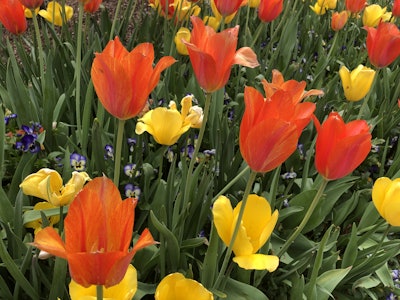 Photo: Jill Odom/Total Landscape Care
Photo: Jill Odom/Total Landscape CareJust as surely as the warm hues of fall we are enjoying will fade into a muted winter, so will winter give way to a colorful spring palette. Among the first to announce this change in season are spring-flowering bulbs, such as tulips, daffodils and hyacinths. Their vivid colors provide a sharp contrast to the dull shades of winter, and are a welcome sight as the chill of winter fades away.
If you’ve never planted bulbs before, then you need to know that now’s the time (for most of the United States) to get them in the ground. While your clients may be reluctant to spend the money now on something they won’t see until spring, it’s well worth your effort to offer this service to them. Not only will they thank you next spring, the bright flower display will probably prove irresistible enough to grab the attention of a few more potential clients in the area. Here’s what you need to know:
Planting time
You should wait until soil temperatures drop to below 60 degrees Fahrenheit to plant your bulbs. For most regions, this is typically between September and November. However, if you’re in a warmer climate, you can procrastinate until January. Know that even in a cooler climate you can potentially plant bulbs as late as December, as long as the ground remains unfrozen.
Selecting bulbs
Choosing which bulbs to plant can be overwhelming. There are literally hundreds of varieties of tulips alone. So when you’re making your selection, pay attention to when they bloom (early, mid or late season), to height (short is less than 8 inches, medium is 8 to 18 inches, and tall is more than 18 inches), and, of course, to color. You will also want to consider your climate. If you live in a cooler climate, almost all varieties will cooperate. In the South, though, you’ll want to choose early bloomers, such as Darwin hybrids, Parrot tulips and Triumph varieties. Make sure the bulbs you choose are firm and solid; avoid those that are lightweight or shriveled.
Locating bulbs
Tulips prefer full sun and sandy, well-drained soil. If this doesn’t describe your location, you can improvise by adding peat moss or compost to the bed and mounding the soil, which will help it drain. Tulips will also tolerate partial shade, although full sun is ideal. Many experts recommend planting them under deciduous trees. The tulips will get adequate sun to bloom before the trees leaf out.
Arranging bulbs
If you want to plant several colors, mix up the bulbs before setting them out. The colors will be much more random this way. If you try to arrange them by color, it will look contrived. And don’t skimp on numbers. Even a small bed (5 feet by 5 feet) can require 300 bulbs that are spaced 4 to 6 inches apart. Also, resist the temptation to plant bulbs in rows. They look their best when they’re planted in informal groups, not in arrangements.
Planting bulbs
When planting, till soil to about a foot deep, adding fertilizer, and plant bulbs pointed-end up, about three times deeper than the height of the bulb (usually 6 to 8 inches deep). Water-in after planting to help them develop a strong root system, and add mulch if you live in a cold area. In the South, you’ll need a little more planning. To coax tulips to bloom, you’ll need to refrigerate bulbs at 40 degrees Fahrenheit for about eight weeks before planting in January. Just be sure to keep them dry. Try wrapping them in paper towels and paper sacks and placing them in your vegetable bin. Plant them as soon as you remove them from the fridge.








